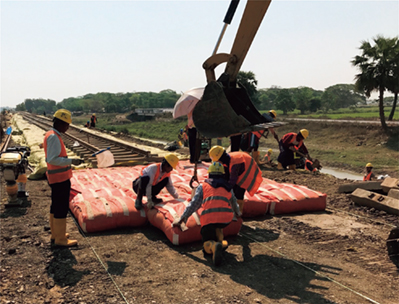Master Techniques from Japan to the World 1
Strengthening the Ground Under Myanmar's Railroads
– The New Development of D-Box to Prevent Ground Subsidence and Collapse

Laying D-Box sandbags for the construction of a railway line in Myanmar(Photo: Metry Co., Ltd.)
Myanmar is a country with high annual precipitation and high humidity exceeding 80%, where the rainy season lasts from May through October. The Ayeyarwady Region of Myanmar in particular, which covers an area of roughly 30,000 km2 in the coastal wetlands of the south, features very soft ground and often experiences severe damage caused by heavy rains and high tides. Furthermore, a type of cohesive soil similar to sludge is often built up on the surface, over which such structures as train tracks, roads, and buildings are constructed, so not only is subsidence and ground collapse a frequent issue, but it further causes the deterioration of facilities and equipment, rendering the construction and maintenance of infrastructure difficult. To meet the need for ground improvement under these conditions, Myanmar Railways (MR) began cooperating with Metry Co., Ltd. (located in Kazo City, Saitama Pref.), a company specializing in the areas of building technology and product development for the construction industry. In October 2016 MR started to build and maintain train tracks through the project entitled “Verification Survey with the Private Sector for Disseminating Japanese Technologies for a box shaped soil bag with internal binding system in railway infrastructure with” that Metry Co., Ltd. proposed to the JICA's Support for Japanese Small Medium-sized Enterprises (SMEs) Overseas Business Development. This product, named D-Box,* developed by Mr. Futoshi Nomoto, CEO of the company, was selected to strengthen the foundations to support the types of structures described above. According to Mr. Nomoto, “D-Box is a bag for ground reinforcement with internal binding system which has a stable shape that does not easily become deformed, providing a reinforcing effect even in extremely soft ground such as wetlands where this is usually quite difficult.”
The D-Box method does not require large and heavy machinery or other special tools, nor does it require solidifying agents such as cement and so on, while local soil or the cohesive soil can often be used as the material depending on the required application (sand is used in Myanmar). This means that material costs can be reduced and no cost for its transportation is incurred. The use of natural materials from the local surroundings means there is no negative impact on the environment, and the method maintains water permeability in an effort to minimize the effect on the underground environment (such as interference with water pipes). The installation of D-Box also takes relatively little effort, making it appropriate for the Myanmar construction environment by reducing the term required for installation.
For this project, a rural railroad was chosen that was inaccessible to heavy equipment, making it impossible to use normal construction methods. For this trial use of D-Box for rail maintenance, it was found that construction could be carried out using only the local workers. Mr. Nomoto thinks that there is a high demand for the infrastructure development in rural areas faced with poverty and depopulation due to the difficulty of bringing agricultural products to urban markets. The reinforcement of the ground using D-Box will enable reliable train operation, which is expected to further lead to the promotion of stronger and smoother logistics. MR is planning to conduct maintenance a total of approximately 176 km of rail road, while it is not decided yet from where they will start.
When Myanmar entered the rainy season, the ground reinforcement effects of D-Box were proven that track sections in which D-Box was installed remained stable while other ground areas were heavily damaged. Mr. Nomoto explains how this works saying, “Actually, in addition to the D-Box bags directly maintaining the ground under the tracks, the installation process also has the effect of compacting and solidifying the ground underneath. While it appears that the bags are just laid on the surface, soil is actually hardened to a significant depth underneath to strengthen the ground.”

Handing over the site after completion of the railway line construction(Mr. Nomoto is on the left) (Photo: Metry Co., Ltd.)
The problems associated with railway infrastructure development have piled up, such as strengthening such difficult areas that MR had not previously been able to address. Mr. Nomoto passionately explains his ongoing challenges, saying “Next we will need to train Myanmar engineers. We will also have to spread awareness of the theory and efficacy of D-Box among the leading members of the Myanmar Engineering Society in order to gain approval for D-Box. Furthermore, in the future, I hope to contribute to the project so that D-Box becomes an inexpensive and reliable infrastructural tool for Myanmar, then enabling local residents to produce D-Box by themselves, and to habituate their use as a road repair tool.”
* D-Box (construction method): A construction method that achieves combined effects of ground reinforcement, vibration reduction, and liquefaction reduction based on the theory, effects, and track record of the SoilBAG Construction Method proposed by Hajime Matsuoka, Professor Emeritus at the Nagoya Institute of Technology.
Next Page >>
Main Text | Statistics and Reference Materials | Stories from the Field | Master Techniques from Japan to the World | ODA Topics
